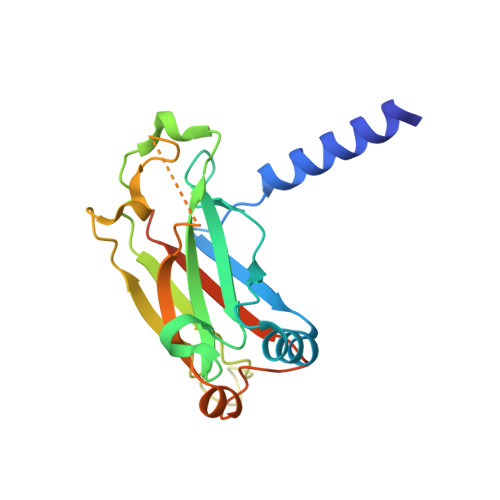Traf4 is a Novel Phosphoinositide-Binding Protein Modulating Tight Junctions and Favoring Cell Migration.
Rousseau, A., Mcewen, A.G., Poussin-Courmontagne, P., Rognan, D., Nomine, Y., Rio, M.-C., Tomasetto, C., Alpy, F.(2013) PLoS Biol 11: 1726
- PubMed: 24311986
- DOI: https://doi.org/10.1371/journal.pbio.1001726
- Primary Citation of Related Structures:
3ZJB - PubMed Abstract:
Tumor necrosis factor (TNF) receptor-associated factor 4 (TRAF4) is frequently overexpressed in carcinomas, suggesting a specific role in cancer. Although TRAF4 protein is predominantly found at tight junctions (TJs) in normal mammary epithelial cells (MECs), it accumulates in the cytoplasm of malignant MECs. How TRAF4 is recruited and functions at TJs is unclear. Here we show that TRAF4 possesses a novel phosphoinositide (PIP)-binding domain crucial for its recruitment to TJs. Of interest, this property is shared by the other members of the TRAF protein family. Indeed, the TRAF domain of all TRAF proteins (TRAF1 to TRAF6) is a bona fide PIP-binding domain. Molecular and structural analyses revealed that the TRAF domain of TRAF4 exists as a trimer that binds up to three lipids using basic residues exposed at its surface. Cellular studies indicated that TRAF4 acts as a negative regulator of TJ and increases cell migration. These functions are dependent from its ability to interact with PIPs. Our results suggest that TRAF4 overexpression might contribute to breast cancer progression by destabilizing TJs and favoring cell migration.
- Institut de Génétique et de Biologie Moléculaire et Cellulaire (IGBMC), Functional Genomics and Cancer Department, Illkirch, France ; Institut National de la Santé et de la Recherche Médicale (INSERM), U 964, Illkirch, France ; Centre National de la Recherche Scientifique (CNRS), UMR 7104, Illkirch, France ; Université de Strasbourg, Illkirch, France.
Organizational Affiliation:

















